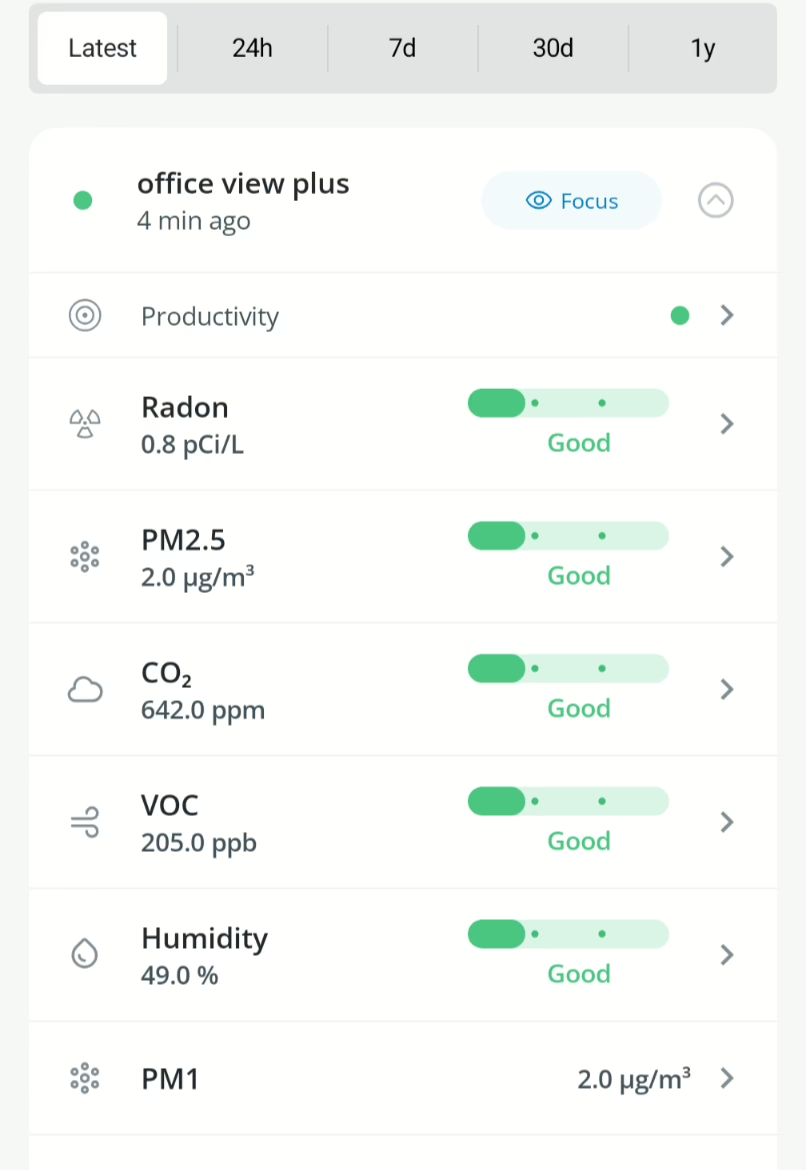Improving Indoor Air Quality: A Step-by-Step Guide
Winter is coming! I’ve been insulating and sealing everything in my home as a way to reduce heating/cooling costs. Due to this, less fresh air is now actively being pulled into my house. Because of this, I’ve been thinking a lot more about making sure the air inside is as pristine as possible. Read on for my journey in improving indoor air quality.
Why Does Indoor Air Quality Matter
As modern humans we spend more and more time indoors. This means we cannot overstate the importance of maintaining good indoor air quality (IAQ). The air we breathe indoors can have a significant impact on our health, cognitive performance, and overall well-being.
Poor IAQ can lead to a range of health problems. These can range from mild symptoms like headaches and fatigue to more severe conditions like respiratory diseases and cancer. According to the World Health Organization (WHO), more than 3 million people die every year due to indoor air pollution. While the majority of these deaths occur in developing countries where indoor burning of solid fuels like wood, coal, and dung is common, I’ll focus more on the types of dangers that occur in modern homes.
While these modern dangers might not lead to outright death, poor IAQ can exacerbate long term health conditions. Even more so for those of us who currently work from home, poor IAQ can affect our cognitive performance and productivity. Studies have shown that reduced classroom air quality can cause a reduction in cognitive performance of pupils, and that good indoor air quality and thermal comfort are prerequisites for human health and well-being.
Establish a Baseline
The first step in improving indoor air quality is to test the air in your home or office. There are several ways to do this. You could get hire a professional for a snapshot in time measurement, but I’ve seen radical changes in IAQ throughout the day. Because of this, I wanted a permanent way to constantly monitor my indoor air quality. My earliest experiments with this involved home made devices with simple sensors. I’ve since settled on integrating AirThings products into my smart home system.
What Impacts Indoor Air Quality
Indoor air pollution can come from a variety of sources, including building materials, household products, and outdoor pollutants that infiltrate the indoor environment. According to the US Environmental Protection Agency (EPA), certain immediate effects of indoor air pollution are similar to those from colds or other viral diseases, making it difficult to determine if the symptoms are a result of exposure to indoor air pollution.
Common Indoor Air Pollutants
Some common indoor air pollutants include:
- Volatile Organic Compounds (VOCs): VOCs are chemicals that evaporate easily. They can be found in household products, such as cleaning supplies, paints, and adhesives. Things like furniture, carpets, and building materials can also emit VOCs. VOCs can cause eye, nose, and throat irritation, as well as headaches and nausea.
- Particulate Matter (PM): PM refers to small particles that can be suspended in the air. This includes dust, pollen, and other airborne particles. High levels of PM can exacerbate respiratory issues like asthma. Cooking, smoking, and outdoor pollution also emits PM.
- Carbon Monoxide (CO): CO is a colorless, odorless gas. Fuel-burning appliances, such as furnaces, water heaters, and generators can emit CO. CO can cause headaches, dizziness, and nausea, and high levels can be fatal.
- Nitrogen Dioxide (NO2): NO2 is a gas. Fuel-burning appliances can emit NO2 but it often arises from outdoor pollution. NO2 can cause respiratory problems, such as coughing and wheezing, and can also exacerbate existing conditions like asthma.
- Radon: Radon is a radioactive gas that can accumulate in buildings, particularly in basements and crawl spaces. Radon can increase the risk of lung cancer and is the second leading cause of lung cancer in the United States.
- Mold and Mildew: Mold and mildew can grow in damp environments, such as bathrooms and basements, and can emit spores that can cause allergic reactions and respiratory problems.
- Pesticides and Insecticides: Pesticides and insecticides used in the home to control pests can also emit toxic chemicals that can cause health problems.
- Asbestos: Asbestos is a mineral that was commonly used in building materials, such as insulation and flooring, until the 1970s. Asbestos can cause lung cancer and mesothelioma, a rare form of cancer.
- Carbon Dioxide (CO2): High levels of CO2 can lead to increased heart rate and blood pressure. This can exacerbate existing respiratory issues. By decreasing blood oxygen levels, elevated CO2 has also been shown to cause headaches, fatigue and drowsiness. Studies have shown high levels can reduce productivity by up to 10%.
Improving Indoor Air Quality
Once you have tested your IAQ, depending on what is out of optimal range, you can take steps to improve it. The AirThings monitoring system that I’ve put together monitors many of these things, but not 100%. I’ve determined that Asbestos isn’t something that I’m extremely concerned about in my home, so don’t currently monitor that. For CO monitoring, I’ve been using Nest products. I haven’t really found a good product for Mold/Mildew outside of keeping the overall humidity in my home low. I currently have not done enough research on indoor pesticide/insecticides (I tend to just avoid using these in general) and NO2.
Mitigation Strategies
There isn’t usually a one size fits all strategy for combating poor IAQ, but depending on what’s problematic, you can consider:
- Increase ventilation: One of the simplest ways to improve IAQ is to increase ventilation. This can be as simple as opening a window or using a whole-house fan. Obviously, this goes against the whole thing that started me down this path, but it’s still one of the most effective ways to clean up your air. I setup my smart thermostats to cycle my fan for 10 minutes every hour just to bring fresh air into the house. I recently started researching Energy Recovery Ventilation (ERV) systems. The next time I need to do more invasive work with my HVAC system, I’m seriously considering installing a full blown ERV setup.
- Maintain your HVAC system: Regularly maintain your heating, ventilation, and air conditioning (HVAC) system to ensure it is working properly and not emitting pollutants. If your HVAC system incorporates filters, regularly clean/change them.
- Use an air purifier: One of the next easiest ways to improve IAQ is by purchasing an air purifier. Air purifiers can help remove many pollutants from the air. Look for a purifier that is specifically designed to remove the types of pollutants you are concerned about. I became an early adopter of the AirThings Renew purifier. In my testing, it’s been very effective. The key with any air purifier is to properly maintain it by cleaning/replacing the filters as needed.
- Reduce VOCs: Some air purifiers can take care of VOCs, but it’s overall best to just try to avoid them. A wide range of products, including paints, adhesives, and cleaning products can emit VOCs. You can avoid VOCs by choosing products that are labeled as “low-VOC” or “VOC-free.” In general, opting to use non-toxic products will benefit you in more ways than just improving your IAQ.
- Mitigate sources of pollution: If you have identified a source of pollution in your home or office, such as a gas stove or a moldy bathroom, take steps to remove or mitigate it. By modifying sources of indoor combustion, you can improve ventilation and reduce what is emitted into the living space.
- Use plants: This has been one of my favorite ways of cleaning up my IAQ. Years ago, I read the results of a NASA indoor clean air study that involved several common plants. Plants are great for mitigating high CO2 levels, but this study found that some were great at removing VOCs and PM as well. English Ivy has been one of my favorites (just because I have an outdoor abundance of it), but peace lilies have been a close second because of how easy they are to propagate. Since I’ve recently been focusing on improving CO2 levels in my workspace, I’ve been using snake plants and bird’s nest fern. An interesting thing that I learned is that many plants actually emit CO2 at night. This makes them not very good for fixing elevated CO2 levels in the bedroom. Most succulents do not do this though, so you might want to consider adding a few of those to your bedroom.
- Use a dehumidifier: High humidity can contribute to mold and mildew growth. Using a dehumidifier can help keep the indoor air dry and healthy.
- Install Radon Mitigation: If testing has shown consistently high radon levels, contact a professional to install a proper mitigation system. I recently had this done and can discuss the process in more detail for anyone interested.
Outcome
Indoor air quality is a critical aspect of our daily lives, and its importance cannot be overstated. Poor indoor air quality can lead to a range of health problems. It can affect our cognitive performance and productivity, and have a significant impact on our overall well-being. We can easily understand the sources of indoor air pollution. Once knowing this, we can take steps to improve indoor air quality. Ultimately, we can create healthier and more comfortable living and working spaces. Who’s already taken steps to monitor and improve their IAQ? I’m interested in hearing about your solutions (Comment or find me on your favorite social platform).




